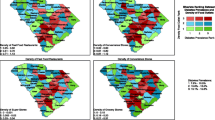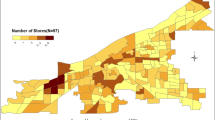Abstract
Objectives
This study examined neighborhood racial and socioeconomic disparities and the density of food and alcohol establishments. We also examined whether these disparities differed by data source.
Methods
This study included commercial data for 2003 and 2009 from InfoUSA and Dun and Bradstreet (D&B) in 416 census tracts in Allegheny County, PA. Food and alcohol establishment densities were calculated by using area and population data from the 2000 US census. Differences between InfoUSA and D&B of food and alcohol densities across neighborhood racial and socioeconomic characteristics were tested using correlations and two-way mixed analysis of variance (ANOVA).
Results
There were differences by data source in the association between neighborhood racial and socioeconomic characteristics and food/alcohol establishment density. There was a positive correlation between grocery store/supermarket density and percentage black, poverty, and percentage without a car among D&B data but not in InfoUSA. Alcohol outlet density (AOD) increased as neighborhood poverty increased for both data sources, but the mean difference in AOD between InfoUSA and D&B was highest among neighborhoods with 25–50 % poverty (Cohen’s d −0.49, p < 0.001) compared to neighborhoods with lower or higher poverty (2003 data). Mean grocery store density increased as percentage poverty increased, but only among D&B (2009 data).
Conclusions
Differences in commercial data in the location and numeration of food and alcohol establishments are associated with neighborhood racial and socioeconomic characteristics and may introduce biases concerning neighborhood food and alcohol environments, racial and socioeconomic disparities, and health.
Similar content being viewed by others
References
Larson NI, Story MT, Nelson MC. Neighborhood environments: Disparities in access to healthy foods in the U.S. Am J Prev Med. 2009;36(1):74–81.
Galster GC. The mechanism(s) of neighborhood effects: Theory, evidence, and policy implications. In: van Ham M et al., editors. Neighborhood effects research: new perspectives. London: Springer; 2012.
Williams DR, Collins C. Racial residential segregation: a fundamental cause of racial disparities in health. Public Health Rep. 2001;116(5):404–16.
Osypuk TL, Acevedo-Garcia D. Beyond individual neighborhoods: a geography of opportunity perspective for understanding racial/ethnic health disparities. Health Place. 2010;16(6):1113–23.
Landrine H, Corral I. Separate and unequal: Residential segregation and black health disparities. Ethn Dis. 2009;19(2):179–84.
Sharkey JR, Horel S. Neighborhood socioeconomic deprivation and minority composition are associated with better potential spatial access to the ground-truthed food environment in a large rural area. J Nutr. 2008;138(3):620–7.
Powell LM, Chaloupka FJ, Bao Y. The availability of fast-food and full-service restaurants in the United States: Associations with neighborhood characteristics. Am J Prev Med. 2007;33(4 Suppl):S240–5.
Hilmers A, Hilmers DC, Dave J. Neighborhood disparities in access to healthy foods and their effects on environmental justice. Am J Public Health. 2012;102(9):1644–54.
LaVeist TA, Wallace Jr JM. Health risk and inequitable distribution of liquor stores in African American neighborhood. Soc Sci Med. 2000;51(4):613–7.
Nielsen AL, Hill TD, French MT, Hernandez MN. Racial/Ethnic Composition, Social Disorganization, and Offsite Alcohol Availability in San Diego County, California. Soc Sci Res. 2010;39(1):165–75.
Romley JA, Cohen D, Ringel J, Sturm R. Alcohol and environmental justice: the density of liquor stores and bars in urban neighborhoods in the United States. J Stud Alcohol Drugs. 2007;68(1):48–55.
Zenk SN, Schulz A, Israel B, et al. Neighborhood racial composition, neighborhood poverty, and the spatial accessibility of supermarkets in metropolitan Detroit. Am J Public Health. 2005;95(4):660–7.
Pearce J, Blakely T, Witten K, et al. Neighborhood deprivation and access to fast-food retailing: a national study. Am J Prev Med. 2007;32(5):375–82.
Franco M, Diez-Roux AV, Hickson DA, et al. Neighborhood characteristics and availability of healthy foods in Baltimore. Am J Prev Med. 2008;35(6):561–7.
Morland K, Wing S, Diez-Roux AV, et al. Neighborhood characteristics associated with the location of food stores and food service places. Am J Prev Med. 2002;22(1):23–9.
Powell LM, Han E, Zenk SN, et al. Field validation of secondary commercial data sources on the retail food outlet environment in the U.S. Health Place. 2011;17(5):1122–31.
Liese AD, Colabianchi N, Lamichhane AP, et al. Validation of 3 food outlet databases: Completeness and geospatial accuracy in rural and urban food environments. Am J Epidemiol. 2010;172(11):1324–33.
Matthews SA, McCarthy JD, Rafail PS. Using ZIP code business patterns data to measure alcohol outlet density. Addict Behav. 2011;36(7):777–80.
Han E, Powell LM, Zenk SN, et al. Classification bias in commercial business lists for retail food stores in the U.S. Int J Behav Nutr Phys Act. 2012;9:46.
Ohri-Vachaspati P, Martinez D, Yedidia M, et al. Improving data accuracy of commercial food outlet databases. Am J Health Promot. 2011;26(2):116–22.
Seliske L, Pickett W, Bates R, et al. Field validation of food service listings: a comparison of commercial and online geographic information system databases. Int J Environ Res Public Health. 2012;9(8):2601–7.
Gustafson AA, Lewis S, Wilson C, et al. Validation of food store environment secondary data source and the role of neighborhood deprivation in Appalachia, Kentucky. BMC Public Health. 2012;12:688.
Burgoine T, Harrison F. Comparing the accuracy of two secondary food environment data sources in the UK across socio-economic and urban/rural divides. Int J Health Geogr. 2013;12:2.
Mendez DD, Duell J, Reiser S, et al. A methodology for combining multiple commercial data sources to improve measurement of the food and alcohol environment: Applications of geographical information systems. Geospat Health. 2014;9(1):71–96.
CensusBureau, Glossary of basic geographic and related terms—Census 2000 (http://www.census.gov/geo/www/tiger/glossary.html#glossary), 2001, US Department of Commerce. Washington, DC.
Treno AJ, Johnson FW, Remer LG, et al. The impact of outlet densities on alcohol-related crashes: a spatial panel approach. Accid Anal Prev. 2007;39(5):894–901.
Feng J, Glass TA, Curriero FC, et al. The built environment and obesity: a systematic review of the epidemiologic evidence. Health Place. 2010;16(2):175–90.
Boone-Heinonen J, Gordon-Larsen P, Kiefe CI, et al. Fast food restaurants and food stores: longitudinal associations with diet in young to middle-aged adults: the CARDIA study. Arch Intern Med. 2011;171(13):1162–70.
Fuller D, Cummins S, Matthews SA. Does transportation mode modify associations between distance to food store, fruit and vegetable consumption, and BMI in low-income neighborhoods? Am J Clin Nutr. 2013;97(1):167–72.
Shier V, An R, Sturm R. Is there a robust relationship between neighbourhood food environment and childhood obesity in the USA? Public Health. 2012;126(9):723–30.
Holsten JE. Obesity and the community food environment: a systematic review. Public Health Nutr. 2009;12(3):397–405.
C.D.C., State Indicator Report on Fruits and Vegetables2013, Atlanta, GA: Centers for Disease Control and Prevention, US Department of Health and Human Services (http://www.cdc.gov/nutrition/downloads/State-Indicator-Report-Fruits-Vegetables-2013.pdf; Accessed July 11, 2013).
Hahn RA, Middleton JC, Elder R, et al. Effects of alcohol retail privatization on excessive alcohol consumption and related harms: a community guide systematic review. Am J Prev Med. 2012;42(4):418–27.
Theall KP, Scribner R, Cohen D, et al. The neighborhood alcohol environment and alcohol-related morbidity. Alcohol Alcohol. 2009;44(5):491–9.
Compliance with Ethical Standards
Conflict of Interest
D. Mendez, K. Kim, C. Hardaway, and A. Fabio have no conflicts of interest to disclose.
Responsible Conduct of Research
No animal or human studies were carried out by the authors for this manuscript. The Institutional Review Board for the University of Pittsburgh approved this study.
Funding Sources
This study was made possible in part by support from The Aetna Foundation (11–02359), Kellogg Health Scholars Program (WK Kellogg Foundation), National Institute on Alcohol Abuse and Alcoholism (T32 AA07453-26), and The Centers for Disease Control and Prevention (U01-CE001630). The views presented here are those of the authors and not necessarily those of the funding agencies, its directors, officers, or staff.
Author information
Authors and Affiliations
Corresponding author
Rights and permissions
About this article
Cite this article
Mendez, D.D., Kim, K.H., Hardaway, C.R. et al. Neighborhood Racial and Socioeconomic Disparities in the Food and Alcohol Environment: Are There Differences by Commercial Data Sources?. J. Racial and Ethnic Health Disparities 3, 108–116 (2016). https://doi.org/10.1007/s40615-015-0120-0
Received:
Revised:
Accepted:
Published:
Issue Date:
DOI: https://doi.org/10.1007/s40615-015-0120-0




